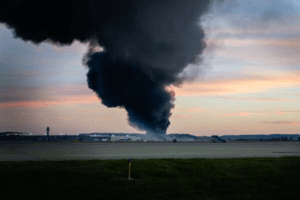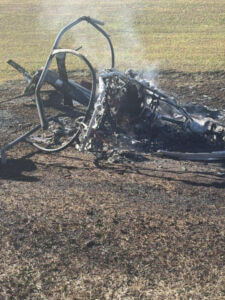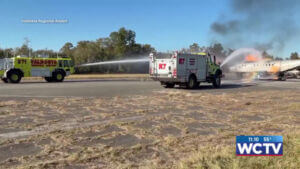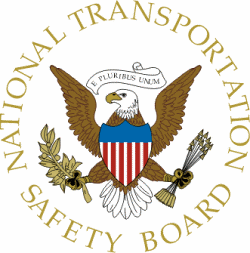Here are the articles for today...
Be safe out there!
Tom
-
Who are the victims of UPS plane crash? Crews face 'apocalyptic' scene.
By Thao Nguyen and Jeanine Santucci
(This story was updated to accurately reflect the most current information.)
As the community in Louisville, Kentucky, mourns the loss of at least a dozen people killed in a fiery United Parcel Service cargo plane crash, authorities warned that answers for family members may still be a way off.
the loss of at least a dozen people killed in a fiery United Parcel Service cargo plane crash, authorities warned that answers for family members may still be a way off.
At least 12 people were killed and multiple others were injured in the Nov. 4 crash, officials said. Officials described an "apocalyptic" scene, recounting the falling debris and a blackened sky over Louisville in the moments after the crash. More are still unaccounted for and the death toll could continue to grow as a slow search for a cause begins, they said.
As of Nov. 5, at least nine people were confirmed to have been killed on the ground, in addition to the plane's three crew members who are believed to be dead, according to authorities. Due to the extent of the damage, Gov. Andy Beshear said coroners may have difficulty identifying the bodies.
"I'm deeply saddened to share that the death toll has risen to 12, with several individuals still unaccounted for," Louisville Mayor Craig Greenberg said in a statement on social media Nov. 5. "No one should face tragedy alone. Please take a moment to hug your loved ones and check on your neighbors."
Also delaying the process is the sheer size of the wreckage search crews need to comb through to look for potential victims, a process that could take several days, authorities said.
“I don’t know how many victims we’re actually looking for. That’s one of the issues,” said Okolona Fire District Chief Mark Little. “The debris zone is so large ... some of that debris is going to have to be moved and searched underneath, so it will take us quite a while.”
Beshear has warned that the death toll could grow as authorities do not expect to find any survivors at the crash site. Earlier on Nov. 5, the governor said 16 families had reported loved ones who were unaccounted for.
Meanwhile, an investigation into the crash produced some preliminary findings about what went wrong.
Inman confirmed during a news conference on Nov. 5 that a large plume of fire erupted around the plane's left wing and one of its three engines detached as the aircraft rolled down the runway.
Here's what we know so far:
NTSB releases photos of recovered 'black boxes'
The National Transportation Safety Board on Nov. 6 released photos of the downed plane's so-called "black boxes": the flight data recorder and cockpit voice recorder. The boxes, which are typically brightly colored despite the name, appeared blackened by fire or smoke exposure in the photos.
Todd Inman, a member of the National Transportation Safety Board, previously said investigators recovered the plane's recorders intact amid the crash debris on Nov. 5, adding that investigators should be able to retrieve data from the system within days.
About 28 members from the NTSB arrived in Louisville on Nov. 5 to begin their investigation, according to Greenberg. The NTSB said the Federal Bureau of Investigation was assisting the agency at the scene with collecting evidence, taking photographs, mapping and measuring the wreckage field, and "generally serving as a force multiplier for the NTSB go team."
Where did the UPS plane crash occur?
The plane crashed in a largely industrial area just south of the Louisville Muhammad Ali International Airport, about 6 miles south of downtown Louisville. The airport is home to UPS Worldport, an international air hub serving more than 300 daily inbound and outbound flights, and processes about 2 million packages each day.
Beshear said that two businesses were directly affected by the catastrophic crash – Kentucky Petroleum Recycling and Grade A Auto Parts. Other businesses, including a nearby convention center, restaurant and Ford Assembly Plant, escaped the blaze.
The crash and ensuing fires also disrupted airport-based operations at the UPS Worldport facility and slowed delivery services. UPS said it resumed operations at the facility on the evening of Nov. 5.
What caused the UPS plane crash?
The Federal Aviation Administration said the National Transportation Safety Board will lead the probe that will investigate the crash. Expect the full results of the inquiry to take a year or more.
The plane's flight data recorder and cockpit voice recorder will be a key part of the investigation.
"We feel comfortable that once we get these to our lab in (Washington) D.C. that we will be able to get a good readout of the applicable data, and that will be yet another point of information that will really help us understand what happened," Inman said.
Inman noted that the NTSB is “not aware” of any staffing shortages due to the government shutdown at the time of the crash. "SDF tower, from what we can see and what we've been told, was at its proper complement,” he said.
The aircraft, a 34-year-old MD-11 freighter, was carrying three crew members aboard when it crashed just after clearing a fence at the end of the runway during takeoff on Nov. 4. The plane hit nearby structures, including a petroleum recycling facility that was set ablaze and exploded, before erupting into flames.
Contributing: Jeanine Santucci and Karissa Waddick, USA TODAY; Reuters
https://www.usatoday.com/story/news/nation/2025/11/06/ups-plane-crash-updates/87115855007/
What We Know About the UPS Plane Crash in Louisville
At least 12 people died when a cargo plane crashed after takeoff in Louisville, Ky. The airport reopened Wednesday morning, but officials warned the death toll could rise.
By Francesca Regalado and Michael Levenson
At least 12 people were killed when a UPS cargo plane that was loaded with 38,000 gallons of fuel for a flight to Honolulu crashed shortly after taking off from Muhammad Ali International Airport in Louisville, Ky., on Tuesday.
plane that was loaded with 38,000 gallons of fuel for a flight to Honolulu crashed shortly after taking off from Muhammad Ali International Airport in Louisville, Ky., on Tuesday.
Airport security footage showed the left engine “detaching from the wing” during takeoff, J. Todd Inman, a member of the National Transportation Safety Board, said on Wednesday. He said that the airplane’s flight data recorder had been recovered and would be sent to a lab for analysis.
The crash ignited a huge fire and scattered debris over a large area south of the airport, sending plumes of black smoke billowing into the sky. The airport, which was closed on Tuesday night, reopened on Wednesday morning. Officials were combing the crash site and warned that the death toll could rise.
Here’s what we know about the crash:
The plane crashed as it was taking off.
Three UPS crew members were on the MD-11 plane as it departed for Honolulu around 5:15 p.m. on Tuesday, the authorities said.
After the plane was cleared for takeoff, there was a “large plume of fire” in the area of the left wing, Mr. Inman, of the N.T.S.B., said on Wednesday. The plane lifted off, gained enough altitude to clear a fence at the end of the runway and then crashed, igniting a massive fire. The detached engine remained on airport property, he said.
The plane, which was loaded with 38,000 gallons of fuel, hit two businesses, including a petroleum recycling facility, Gov. Andy Beshear of Kentucky said. Some storage tanks containing propane and oil at the crash site ruptured, but the fire was almost entirely contained, Brian O’Neill, chief of the Louisville Fire Department, said on Tuesday.
There was no hazardous cargo on the plane, Mayor Craig Greenberg of Louisville said. Mr. Beshear said on Wednesday that he was declaring a state of emergency to allow the state to quickly deploy resources to the crash scene.
At least 12 people were killed.
The authorities said that at least 12 people had died from the crash. The three crew members aboard the plane were believed to be among the dead, Mr. Greenberg said. The names of the victims have not been released.
Nine people were still missing, Mr. Greenberg said on Thursday. Three of them were employees of Grade A Auto Parts, a business that was hit, said Joey Garber, the company’s chief operating officer.
After the crash, 15 victims were brought to hospitals that are part of the University of Louisville, and were treated for burns, shrapnel wounds and other injuries, Jason W. Smith, the chief executive of the university health system, said on Wednesday. Thirteen patients were discharged but two were still in critical condition on Wednesday, he said.
Louisville is the main air hub for UPS.
The crash disrupted cargo operations for UPS, which has its largest air cargo hub, called Worldport, in Louisville. In a statement, UPS called the city the home of its airline and thousands of employees, and said that package sorting operations there would be halted overnight.
The Louisville airport was the world’s fifth busiest for cargo traffic last year, behind airports in Hong Kong, Shanghai, Memphis and Anchorage, according to Airports Council International, an industry lobbying group.
The airport reopened Wednesday morning but officials said that delays and cancellations were likely. A shelter-in-place order that was issued Tuesday evening was reduced to a quarter-mile radius around the airport. The local school district said classes would be canceled on Wednesday.
Before Wednesday, the most recent crash involving a UPS plane happened in 2013, when a jet that departed from Louisville crashed in Birmingham, Ala., killing its two pilots.
https://www.nytimes.com/2025/11/04/us/plane-crash-louisville-kentucky-ups.html
Helicopter crashes at McMinn County Airport
by: Gregory Raucoules
ATHENS, Tenn. (WATE) — One person was injured in a helicopter crash at the McMinn County Airport on Tuesday.
in a helicopter crash at the McMinn County Airport on Tuesday.
McMinn County Sheriff Joe Guy posted on social media around 3:30 p.m. that a small helicopter had crashed with the pilot being treated at the scene for minor injuries. No other people were on board at the time of the crash.
The pilot, who owned the helicopter, said it had lost power, resulting in the crash, according to a McMinnn County Sheriff’s Office investigative report. He said he was okay and refused transport from emergency medical services. MCSO preserved the scene and the Federal Aviation Administration plan to investigate, the report said.
Guy asked the public to avoid the area while emergency personnel cleared the scene.
A post on the McMinn County Airport Facebook page confirmed that everyone was okay and expressed gratitude to airport personnel and first responders for their swift action.
https://www.wate.com/news/local-news/helicopter-crashes-at-mcminn-county-airport/?trk=_publishing-image-block
Plane crash training hosted at Valdosta Regional Airport
Tim Hood with the airport said the training is required by the FAA
By WCTV Staff
VALDOSTA, Ga. (WCTV) - Valdosta Regional Airport hosted a live fire training from a simulated plane crash on Wednesday.
hosted a live fire training from a simulated plane crash on Wednesday.
The Valdosta Police Department took part in the training alongside the Valdosta Fire Department and SGMC Health EMS, according to a VPD Facebook post.
Tim Hood with the airport said the training is required by the FAA and includes first responders from the City of Valdosta and Lowndes County.
In addition to a plane crash simulation, crews tended to injuries from mock patients and even transported them to the hospital.
“Our officers worked to secure the scene, coordinate response efforts, and ensure our partner agencies could operate safely,” the Valdosta Police Department wrote.
Hood said the training is to stay as prepared as possible for worst-case scenarios and to ensure all agencies can work together smoothly in an emergency.
https://www.wctv.tv/2025/11/06/plane-crash-training-hosted-valdosta-regional-airport/
NTSB Final Report: Champion 7GC
About 25 Days (9.3 Hours) Before The Accident, The Airframe Was Modified With Different Landing Gear Legs, Wheels, And Brakes
Location: Haskell, Oklahoma Accident Number: CEN26LA002
Date & Time: October 1, 2025, 12:45 Local Registration: N621E
Aircraft: Champion 7GC Aircraft Damage: Substantial
Defining Event: Loss of control on ground Injuries: 1 Minor
Flight Conducted Under: Part 91: General aviation - Personal
Analysis: The pilot reported that during the landing roll on the dry grass strip, he was making corrections with the brakes and the airplane nosed over, coming to rest inverted. The pilot assumed that he was “a bit too aggressive” with the brakes. The airplane sustained substantial damage to the right wing strut and the rudder. The pilot reported there were no preimpact mechanical malfunctions or failures with the airframe or the engine that would have precluded normal operation. The pilot further reported that the accident could have been prevented by “less or no excessive braking” during the landing roll.
About 25 days (9.3 hours) before the accident, the airframe was modified with different landing gear legs, wheels, and brakes. Additionally, tundra tires were installed. The pilot reported that he thought he had become familiar with the recent modifications, but the nose over revealed that he probably wasn’t as familiar with the braking capability of the tundra tires as he thought he was.
According to FAA Advisory Circular Systems and Equipment Guide for Certification of Part 23 Airplanes and Airships 23-17C, tundra tire installations on airplanes may reduce brake effectiveness during a braked landing and may result in an increased tendency to nose over during landing. The Airframes Alaska Installation Instructions and Instructions for Continued Airworthiness for Alaskan Bushwheel Tundra Tires ABI-Tire-ICA discusses post-installation testing and states: Always stay within the aircraft manufacturer’s limits. When your tundra tire installation is complete and inspected, and the brakes are safe, verify the function, ability, and adequacy of the whole system by conducting ground and air practice/comparison test runs at a safe area/altitude at your gross weight. Make note of any operational differences and include these in your flight planning, decision making, and operating techniques.
Probable Cause and Findings: The National Transportation Safety Board determines the probable cause(s) of this accident to be -- The pilot’s excessive braking during the landing roll, which resulted in a nose over. Contributing to the accident was the pilot’s lack of experience with the recently installed brakes and tundra tires.
FMI: www.ntsb.gov

Today in History
39 Years ago today: On 6 November 1986 A British International Helicopters Boeing Vertol BV234LR Chinook crashed at sea while on approach to Sumburgh, Shetland, United Kingdom, killing 45 occupants; 2 survived the accident.
| Date: | Thursday 6 November 1986 |
| Time: | 11:31 LT |
| Type: | Boeing Vertol 234LR |
| Owner/operator: | British International Helicopters |
| Registration: | G-BWFC |
| MSN: | MJ004 |
| Year of manufacture: | 1981 |
| Total airframe hrs: | 7690 hours |
| Engine model: | Lycoming ALL5512 |
| Fatalities: | Fatalities: 45 / Occupants: 47 |
| Other fatalities: | 0 |
| Aircraft damage: | Destroyed, written off |
| Category: | Accident |
| Location: | North Sea, 2.5 mi E of Sumburgh - United Kingdom |
| Phase: | Approach |
| Nature: | Offshore |
| Departure airport: | Brent Charlie Offshore Installation |
| Destination airport: | Sumburgh, Shetland (LSI/EGPB) |
| Investigating agency: | AAIB |
| Confidence Rating: | Accident investigation report completed and information captured |
Narrative:
A British International Helicopters Boeing Vertol BV234LR Chinook crashed at sea while on approach to Sumburgh, Shetland, United Kingdom, killing 45 occupants; 2 survived the accident.
Crashed into the North Sea when the forward transmission spiral bevel ring gear failed. This caused the rotor synchronisation to be lost and the aft rotors cut through the aircraft as it broke up in mid air. The underlying causes were the inadequacy of a previously accepted test program and the failure of a stringent inspection programme.
Only two of the 47 POB (44 passengers and 3 crew) survived.
The helicopter was normally based at Aberdeen Airport but had been based at Sumburgh Airport since 3 November 1986 to operate a shuttle service from the Shell Brent field in the East Shetland Basin. On 6 November the first flight was delayed due to an oil leak from an engine gearbox that was soon rectified and the aircraft left Sumburgh at 08:58 with 40 passengers for the Brent Field. The aircraft visited three platforms with exchanges of freight and passengers then departed Brent Platform C at 10:22 with 44 passengers on board for return to Sumburgh Airport. It transited at a height of 2,500 feet, and as it approached Sumburgh it was cleared to descend to 1,000 feet. Reporting 4.5 miles from the airfield, the controller cleared it to land on helicopter runway 24. Nothing else was heard.
The crew noticed an increased noise level in the flightdeck followed by a bang. Despite applying full cyclic pitch control the aircraft did not respond and nose-dived towards the sea from a height of 150 feet (50 m). The helicopter hit the sea, broke up and sank. A Coastguard search and rescue helicopter which had just departed Sumburgh Airport reported liferafts in the sea. It then observed a survivor clinging to a substantial piece of wreckage. While they winched the man on board another survivor was noted amongst the floating bodies. With no signs of other survivors the Coastguard helicopter flew the survivors to Lerwick for transfer to hospital.
The AAIB made three safety recommendations:
1) Certification procedures be reviewed so that all modifications to vital components are adequately scrutinised and tested before approval and more closely monitored after their introduction into service.
2) The Civil Aviation Authority should report on the progress that has been made towards the early incorporation of a specification for suitable condition monitoring systems into airworthiness requirements for helicopters and indicate the time scale and scope of likely developments.
3) Requirements relating to the ADELT (Automatically Deployable Location Transmitter) equipment, including location, crashworthiness, protection and power supplied, be review.ed in the light of the accident. (The beacon did not operate due to impact damage to the aft part of the aircraft)
![]()